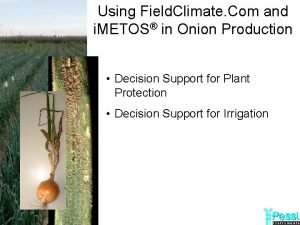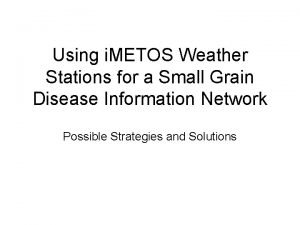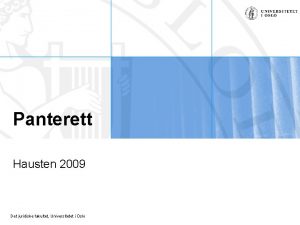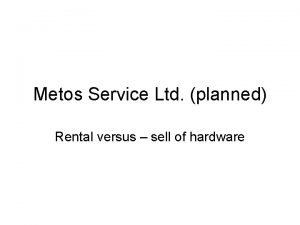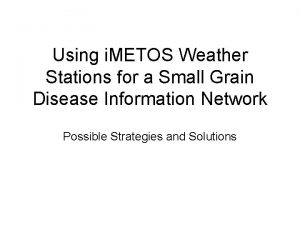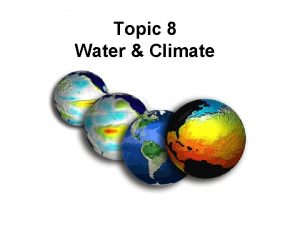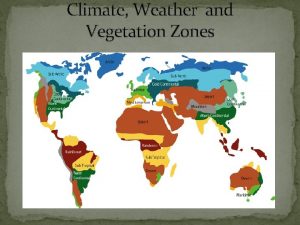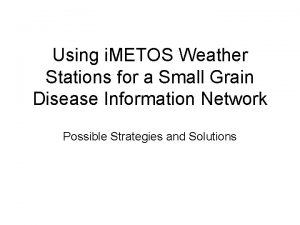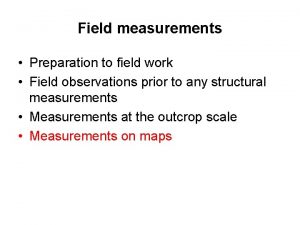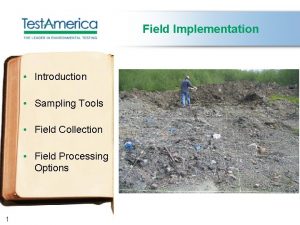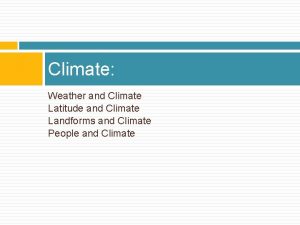Using Field Climate Com and i METOS in



























- Slides: 27

Using Field. Climate. Com and i. METOS® in Onion Production • Decision Support for Plant Protection • Decision Support for Irrigation

i. METOS distribution in different Countries September 2009

Data presentation in Field. Climate. Com


i. METOS • GPRS or CSD-Dial in based internet connection • SMS alert messages for • Frost • Soil Moisture • …. • Climate sensors for • Disease models • Evapotranspiration • … • Soil moisture sensors • Watermak • Tensiometer • Ech 2 o Probes • Sentek Enviroscan • Sentek easy ag • Sentek Tri. Scan • Temperature Monitoring in • Silos • Plastic Tunnels • …. .

Onion Disease Models on Field. Climate. Com • Downy Mildew (Peronospora destructor) • Botrytis Leaf Blight (Botrytis sqamosa) • Botrytis Leaf Spot (Botrytis cinerea) • Stemphylium Leaf Blight (Stemphylium versicarium) • Purple Blotch (Alternaria porri)

Downy Mildew (Peronospora destructor) Downy mildew attacks onions in many parts of the world. It can become severe on leaves of commer-cially grown onion plants and on leaves and seed stalks of onions grown for seed, especially when relatively cool, moist weather prevails. Other reported hosts are shallot, leek, garlic, and chive. Symptoms and economic impact: Downy mildew is characterized by pale green, yellowish to brownish areas of oval to cylindrical size and shape on infected leaves or seed stalks. These areas may consist of alternating yellow and green layers of tissue. The causal organism of Downy Mildew produces fruiting bodies and spores called sporangia on the surface of the leaves and seed stalks. The masses of spores are at first transparent to grayish, and then rapidly become violet in color. Leaves become girdled in the region where mildew develops and the leaves collapse. This results in dead leaf tips that usually can be seen within defined regions in a field. The dead leaf tissue is rapidly colonized by purple blotch, which is dark in color. Downy Mildew seldom kills onion plants, but bulb growth may be reduced. Bulb tissue, especially the neck, may become spongy and the bulb may lack keeping quality.

Peronospora destructor Biology: Dormant Period: It is believed that the Downy Mildew fungus overwinters primarily as mycelium in infected onions that remain in onion fields or in nearby cull piles. The pathogen also can overwinter in perennial varieties of onion in home gardens. Infection: Spores are formed on systemically infected material form the last year or on mature lesions from the actual season at night when high humidity and temperatures of 4– 25 C occur, with an optimal temperature of 13 C. The spores mature early in the morning and are disseminated during the day. Spores remain viable for about 4 days. Germination occurs in free water from 1– 28 C with an optimal range of 7– 16 C. Rain is not needed for infection if heavy dews occur continuously during the night and morning hours. Incubation Period: The mycelium of Downy Mildew in leaves of infected onion plants in commercial bulb production fields produces a new crop of spores called conidia in cycles of approximately 11– 15 days.

MILIONCAST , Peronospora destructor Model: Sporulation: The greatest number of sporangia was produced at 100% relative humidity (RH), and sporulation decreased to almost nil when humidity decreased to 93% RH. Infection: Downy mildew spores require temperatures between 4 to 25°C and anywhere between 2 to 7 hours of leaf wetness to germinate. Incubation Period: The mycelium of Downy Mildew in leaves of infected onion plants in commercial bulb production fields produces a new crop of spores called conidia in cycles of approximately 11– 15 days.

Botrytis Leaf Blight (Botrytis sqamosa) Botrytis leaf blight is a fungal disease that occurs in many of the onion growing areas of the world. The causal organism, Botrytis squamosa, causes leaf spots (lesions) and maceration of leaf tissue resulting in leaf dieback and blighting. The lesions are whitish in color, from 1 -5 mm in length, and most are surrounded by greenish-white halos that appear water-soaked when first formed. The centers of the lesions usually become sunken, straw colored, and may develop a characteristic slit that is oriented lengthwise in the lesion. Older onion leaves are more susceptible than younger leaves to lesion formation and blighting. Under favorable environmental conditions (high rainfall, extended periods of leaf wetness, high relative humidity, and moderately warm temperatures 9°C 25°C), Botrytis Leaf Blight can result in reduced onion bulb growth and yield.

Botrytis Leaf Blight (Botrytis sqamosa)

Botrytis Leaf Blight (Botrytis sqamosa) Infection Some infection can occur with only seven hours of leaf wetness if temperatures are near the optimum range of 15°C to 20°C. As temperatures deviate from this optimum range, longer periods of leaf wetness are required for infection. For example, temperatures at 9°C and 26°C are conducive to infection, provided that leaf wetness periods increase to 10 hours. Levels of infection should be regarded as being most severe if leaf wetness periods approach 14 hours, provided that temperatures are in the optimum range. Severe levels of infection can also occur at 9°C and 26°C if leaf wetness periods last for nearly 20 hours.

Botrytis Leaf Blight (Botrytis sqamosa) Infection Model

Botrytis Leaf Spot (Botrytis cinerea) White sunken spots on leaves are usually the first sign of infection; spots are small (0. 5 mm up to 6 mm long) and tend to be oval. They sometimes have a light green halo and may appear water soaked. The epidermis around the spots may be silvery. When numerous spots are present, leaf tips die back and whole leaves may be killed. Botrytis cinerea spores land on leaf surfaces and, in the presence of moisture, germinate and produce enzymes that kill leaf tissue. The fungus damages the leaf by causing leaf spotting. Leaf surfaces must be wet by dew or rain for long periods (20 or more hours) for leaf spot to develop. Optimum temperature for germination of spores is 15°C; optimum temperature for mycelial growth is 18°C to 25°C.

Botrytis Leaf Spot (Botrytis cinerea) on Onions Risk Model B. cinerea infections are related to free moisture. In open field production leaf wetness is a good indicator for this. The graph indicates a leaf wetness period leading to B. cinerea risk of 30%. Dry days will reduce the risk again.

Botrytis cinerea Risk in Austria during May 2008 There are close to 2 weeks left where we would not need a fungicide coverage.

Stemphylium leaf blight and stem rot Stemphylium leaf blight is caused by the fungus Stemphylium vesicarium. Small, light yellow to brown and water-soaked lesions develop on leaves. These small lesions grow into elongated spots that frequently coalesce resulting in blighted leaves. Lesions usually turn light brown to tan at the center and later dark olive brown to black as the spores of this pathogen develop. Stemphylium vesicarium normally invades dead and dying onion tissue, such as leaf tips, purple blotch and downy mildew lesions, injured tissue, and senescent tissue. Infection usually remains restricted to leaves and does not extend into the bulb scales. Lesions generally occur on the side of the leaf facing the prevailing wind. Long periods of warm wet conditions encourage disease development.

Stemphylium versicaricum on onions The Stemphylium versicarium model is based on the work of SUHERI and PRICE in onoins and LLorent, VILARDELL, BUGIANI, GHERARDI and MONTESINO in pear. Infection curves for weak middle and heavy infections are computed. Whether with an weak infection or with a middle more or heavy infection to be only treated must depends on the disease history of the location.

Stemphylium versicaricum on onions The model outputs Infections in three severity classes. Stemphylium infections are often together with Alternaria porri infections. Therefore the following model is quite frequent used for both.

Purple blotch, caused by Alternaria porri, is probably one of the most common diseases of onion and is distributed worldwide. The fungus overwinters as mycelium in onion leaf debris. During periods favorable for sporulation (leaf wetness or relative humidity of 90 percent or higher for 12 or more hours), inoculum becomes wind-borne and spreads to new foliage. Infection is highest at 25°C. Older plant tissue is more susceptible to infection by purple blotch. Thrips feeding is thought to increase susceptibility of onion tissue to this disease. Symptoms: Purple blotch symptoms are first observed as small, elliptical, tan lesions that often turn purplish-brown. Concentric rings can be seen in lesions as they enlarge. A yellow halo surrounds lesions and extends above and below the actual lesion itself for some distance. Lesions usually girdle leaves, causing them to fall over. Lesions may also start at the tips of older leaves.

Purple blotch and Tom Cast TOMCAST is derived from the original F. A. S. T. (Forecasting Alternaria solani on Tomatoes) model developed by Dr. Madden, Pennypacker, and Mac. Nab? at Pennsylvania State University (PSU). The PSU F. A. S. T. model was further modified by Dr. Pitblado at the Ridgetown College in Ontario into what we now recognize as the TOMCAST model. DSV are: A Disease Severity Value (DSV) is the unit of measure given to a specific increment of disease (early blight) development.

Purple blotch and Tom Cast: The use of the DSV A DSV is a numerical representation of how fast or slow disease (early blight) is accumulating in a tomato field. The DSV is determined by two factors; leaf wetness and temperature during the "leaf wet" hours. As the number of leaf wet hours and temperature increases, DSV accumulate at a faster rate. Conversely, when there are fewer leaf wet hours and the temperature is lower, DSV accumulate slowly if at all. When the total number of accumulated DSV exceeds a preset limit, called the spray interval or threshold, a fungicide spray is recommended to protect the foliage and fruit from disease development. The spray interval (which determines when you should spray) can range between 15 -20 DSV. The exact DSV a grower should use is usually supplied by the processor and depends on the fruit quality and end use of the tomatoes. Following a 15 DSV spray interval is a conservative use of the TOMCAST system, meaning you will spray more often than a grower who uses a 19 DSV spray interval with the TOMCAST system. The tradeoff is in the number of sprays applied during the season and the potential for difference in fruit quality.

Irrigating Onions to achieve maximum yield and maximum quality • Reducing number of non single center bulbs • Reducing pink rot and Fusarium basal Rot No Water Stress No Water Logging

Irrigating Onions to achieve … How to Measure Soil Water Status in Permanent Logging Systems • Volumetric Soil Water Contend by Capacitive Sensors • Availability of Soil water by Tensiometric Sensors Common requirements to all systems (Pre Selecting Criteria) • Giving Fast and Useful Information • Giving Comparable Information • Robust • Easy to install • Cost effective

Irrigating Onions to achieve … Water Availability assessed by Tensiometric Sensors In an unsaturated soil, water is held in the soil by surface tension. This generates frces that bind the water to the soil particles. The magnitute of this force depend on the soil moisture content. as dryer the soil as larger the force. Other words used for soil water tension are soil suction or matrix potential. The relationship between soil moisture content and soil moisture tension depends on soil texture. For a given soil moisture tension, soil moisture content of sandy loam will be less than of clay loam. The relationship between soil moisture tension and soil moisture content is described by the soil moisture release curves. Available and recommended Sensors • Tensiometers • Watermark Sensors (Irrometer) • MPS-1 (Decagon)

Irrigating Onions to achieve … Comparing Capacitive and Tensiometric Sensors in Use Capacitive sensors Tensiometric sensors + Fast reaction on changes + Showing water availability + Frost proof + Some are Frost prove – No information on – Slow reaction availability of moisture – Some are not Frost prove Sensors we support: 10 HS, Echo 5, Sentek (Enviroscan, Tri. Scan), Aquaspy (all types) Our Recommendation: Use both types of sensors

Irrigating Onions to achieve … Combine Capacitive and Tensiometric Sensors All capacitive sensors can be combined with the tensiometric sensors supported by i. METOS, but we recommend by cost effectivness to combine • 2 10 HS and 1 MPS-1 per measurement point • Use the 10 HS to achive the information about the water infiltration and the MPS-1 to irrigate before reaching -55 c. Bar water suction • 3 10 HS and 3 Watermark sensors to measure 2 or 3 sites parallel • Use the watermark sensor to irrigate before reaching -55 c. Bar water suction
 Field climate metos
Field climate metos Dậy thổi cơm mua thịt cá
Dậy thổi cơm mua thịt cá Cơm
Cơm Metos weather station
Metos weather station Metos bergen
Metos bergen Metos service
Metos service I metos
I metos Climate change 2014 mitigation of climate change
Climate change 2014 mitigation of climate change Gauss law of magnetism
Gauss law of magnetism Electric field and magnetic field difference
Electric field and magnetic field difference Database field types and field properties
Database field types and field properties Field dependent definition
Field dependent definition Difference between electric field and magnetic field
Difference between electric field and magnetic field Individual differences factors
Individual differences factors Field dependent vs field independent
Field dependent vs field independent E field h field
E field h field System.collections.generics
System.collections.generics Unit 25 special refrigeration system components
Unit 25 special refrigeration system components Canada's natural vegetation regions
Canada's natural vegetation regions Mountain humidity
Mountain humidity Climate and vegetation of north america
Climate and vegetation of north america Scandinavian climate and geography
Scandinavian climate and geography How does wind affect weather and climate
How does wind affect weather and climate Weather climate and society
Weather climate and society What is this
What is this Which colonial region contained rocky soil and cold climate
Which colonial region contained rocky soil and cold climate Climate and vegetation zones
Climate and vegetation zones Climate change meaning and definition
Climate change meaning and definition
